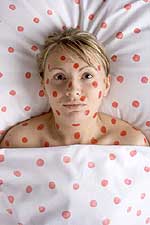Ways to Treat and Prevent Shingles

Sure, you have fantasized about reliving your youth. But this most definitely is not what you had in mind. It seems the virus that gave you chicken pox decades ago has decided to pay a return visit. Only this time round, it has produced shingles, a painful rash that eventually erupts into clusters of pus-filled blisters. Shingles is most common in people over age 50. Shingles' trademark rash typically appears on one side of the body, following the path of the affected nerve from the midline of the chest to the midline of the back. Sometimes it spreads to the face as well. If this happens to you, you should see your doctor right away. If the eyes become involved, you could end up with permanent vision damage. Here are some tips that you can consider to adopt to ease your discomfort.
1. Don't Share Your Pain
Shingles is less infectious than chicken pox because the virus is not airborne. Still, the virus can be transmitted by direct contact. When you have shingles, you should avoid contact with anyone who has not had chicken pox. Wait until the blisters are crusted over, which usually takes four or five days. If you do happen to infect someone, though, the person will develop chicken pox rather than shingles.
2. Go Under Wraps
You can also protect the affected area by wrapping it with an elastic bandage. This will prevent anything from touching or rubbing against the blistered skin. Just be sure the bandage is tight. If it is loose, it will irritate the blisters. Be sure to place a non-adhesive gauze pad over the blisters before wrapping. If you can't wrap the affected area, coat gauze with petroleum jelly, then tape it over the blisters.
3. Apply A Cooling Compress
Soak some gauze or a washcloth in cool, clean water or a saline solution and put it directly on the blisters. The compress will dry out the blisters and speed the healing process. It will also help prevent secondary bacterial infection, which can lead to ulceration and scarring.
4. Pick A Painkiller
Acetaminophen and nonsteroidal anti-inflammatory drugs (NSAIDs) such as aspirin and ibuprofen can relieve shingles pain. If an over-the-counter pan reliever does not help, your doctor may prescribe a stronger medication such as codeine.
5. Choose Lighter Attire
The skin is extra sensitive during a shingles outbreak. The gentlest touch can be perceived as pain. For this reason, it is recommended to wear light, loose fitting clothes, nothing that is restrictive or that rubs the skin.
6. Nip Infection In The Bud
If you notice any signs of infection such as redness, swelling, fever, pain, or pus discharge, treat the blisters immediately with an iodine preparation. These products are available over the counter.
7. Wash Up
Clean the affected area with soap and water, then apply 3 percent hydrogen peroxide. Doing so will help prevent the sores from becoming infected.
About The Author:
Raymond Lee Geok Seng is one of the foremost experts in the health and fitness industry and is a writer specializing in body health, muscle development and dieting. He has spent countless of time and efforts conducting research and share his insightful and powerful secrets to benefit men and women all over the world. He is currently the author of the latest edition of "Neck Exercises and Workouts." Visit http://www.bodyfixes.com for more information.
|